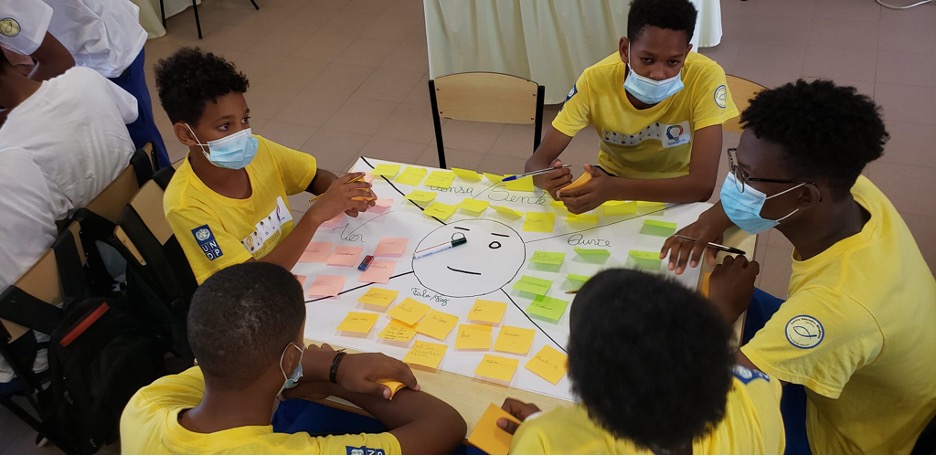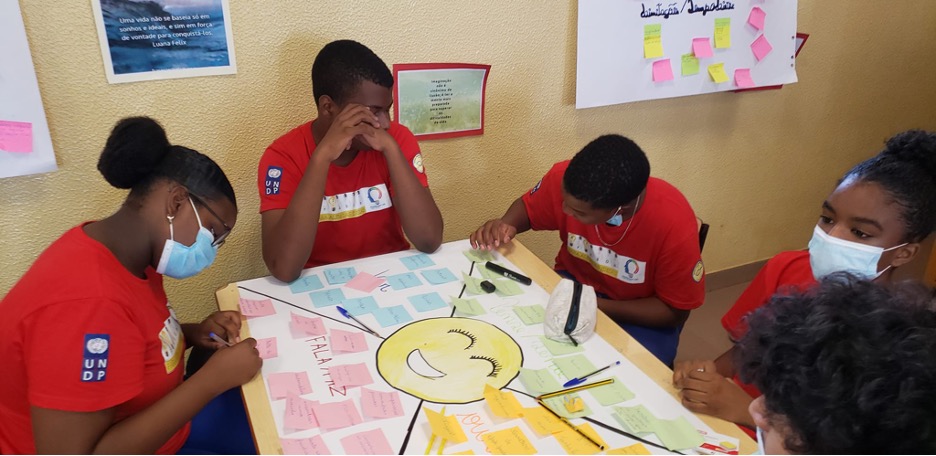Kria-Ason, Design Thinking at School
November 28, 2022
Author: Samory Araújo, Head of Solutions Mapping, UNDP Cabo Verde Accelerator Lab

Why Design Thinking
Design Thinking at school represents a form of stimulus to the student for an autonomous and participatory learning often based on problems of real situations that need to be solved which imposes, therefore, a protagonist role to the student and favors the construction of their knowledge.
The benefits of using Design Thinking in the learning process are many, among them is the transformation in the way of generating learning since it provides the student to think in a different way ("out of the box") and solve problems from the connection of ideas that apparently were not interconnected.
Education is the construction of knowledge and attitudes that happens at various times in the individual's life and are essential for man to be able to integrate into society, so is necessary that the methodologies used allow students to take the initiative to develop increasingly complex activities to make decisions and evaluate the results. Design Thinking favors student autonomy by arousing curiosity and stimulating both individual and collective decision-making and when used by teachers to help lead future professionals from any area of knowledge to critical training. It's an approach that uses creative thinking, teamwork, empathy, creation of concepts, prototyping and testing to understand the proposed problem and idealize solutions.
Kria-Ason
The initiative to take Design Thinking to the school is from the mentor of the Kria_Ason´s project, Hernídia Tavares, discovered by accelerator lab through the work of sense and solutions mapping. The Accelerator Lab Team Cabo Verde supported Design Thinking at School for the innovative solutions by teenagers, with the aim of contributing to the sustainable development of the Cabo Verde municipalities in an increasingly, interconnected, uncertain, volatile, and ambiguous world but also to give them an opportunity to experience activities designed to challenge their creativity, and to discover their talents and to find the tools to explore the world.
When Hernídia Tavares, master’s in science of Innovation, Creativity and Leadership conceived this series of Design Thinking Workshops, she designed it for adolescents cause she “believes that because teenagers are in the process of development of their identity, the chances of contributing to this process are larger, since they are more open to novelty at this stage.”

Pillars and Steps:
Design Thinking is a creative solve-problem approach that has been used globally by reputable companies whenever they seek to bring innovation to their company or business. The Design Thinking for Adolescents consists of four main pillars, namely:
- Acquire knowledge
- Build knowledge
- Share Knowledge
- Experience a New Culture.
The goal is to look at the problems for a different perspective and come up with creative solutions. In partnership with the project Kria-Ason, the Accelerator Lab Team supported Design Thinking at Escola Mira- Flores (a secondary school from Praia city). A total of 76 students participated in two rounds of the workshop for three days each round immersed in the five steps of Design Thinking, namely: Empathy, Problem Definition, Ideation, Prototyping and Testing.
They learned “that many times a problem can’t touch us individually but still a community problem”, so there´s a need to go through the empathy phase so the adolescents can better relate with the challenges of the other. Definition is “from the moment they experience the problem from the others perspective, they have data that allows them to better define the problem”. During the Workshops they learned tools to define problem they were working on. Afterwards they had the ideation phase which is a phase of generating creative ideas through questions that instigate them cognitively to come up with creative answers; they then moved to the prototyping phase which demonstrates the step-by-step of the solution created. From the product design phase to the final consumption phase. Finally, they had the test phase “which is the time to stop and see if the solution they designed really meets the needs of the user, consumer or society”.
The class of students was divided into 6 groups that worked on the following themes:
- Safety
- Inclusion
- Environment
- Entertainment
- Resilience
- Sustainability

Students' Feedback
- “We worked on the issues through Design Thinking workshop which helped us to develop and apply our Creativity ´´.
- “We created solutions to problems that have had a negative impact on our society”.
- “Through exploratory we were able to arrive at solutions-oriented answers”

Learnings
- The workshop team was composed of seven professionals from different areas that proposed to provide these teenagers with tools that would allow them developing empathy for people facing problems. As the students said:
- “We learned make things, among them how to develop our creativity, our concentration and show that we teenagers can also innovate and change the world by using our creativity”.
- They Learning to identify problems impartially “We worked on some activities such as identifying the problems and knowing what people think and talk about these problems; we also had to think about the needs of and perception of people of Praia.” “The most difficult was to work on what the people of Praia think about sustainability: what they say, what they do and what they think about it. It was more challenging because we had to think about others and understand how they think about sustainability.”
- Learn to develop analytical skills for decision making “of the activities we did, the one I liked most was one we had to display all our ideas on a poster, and then reflect on what teenagers and society think about resilience”
- Develop negotiation skills “Our theme was environmental pollution with a focus on marine pollution due to species deaths and subsequently extinction
- Explore creative thinking as problem-solving skill
- To analyze and respect diversity
- Develop teamwork skills
- Explore the capacity for innovation
- Expand their knowledge in different areas

The goal is that these teenagers serve as references in their communities, actively participating in the creation of solutions to social challenges. The highlights of the Kria-Ason workshop are the presentation of the solutions developed to the local authorities, and to raise their awareness about the better inclusion of teenager’s participation in the community life; engaging them in active participation in community life implies going beyond the ideas and theories, it´s implies believing and investigating now in the creative potentials of adolescents, so that we do not have to empower them as adults. Starting to see them from the perspective of potential sources of ideas for innovative solutions is a first step for them to feel valued, perceived, and capable contributing to a development of a whole country.


 Locations
Locations